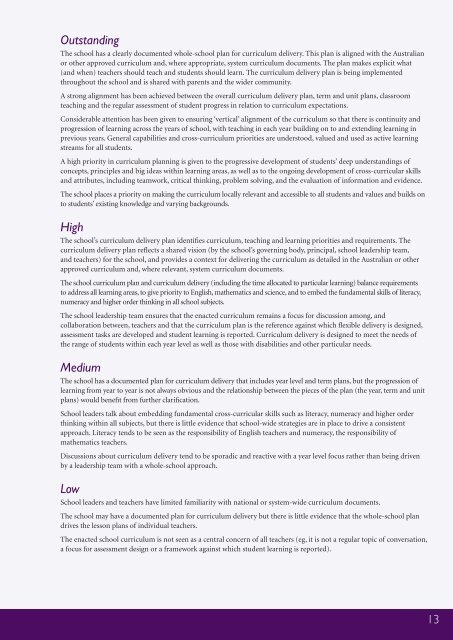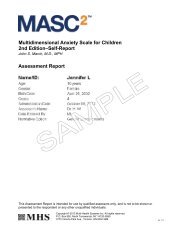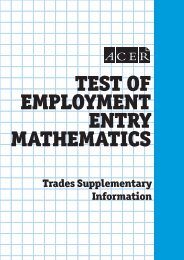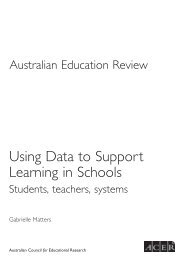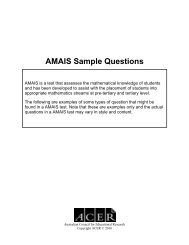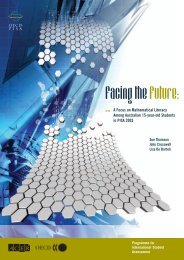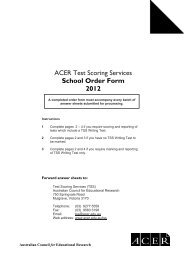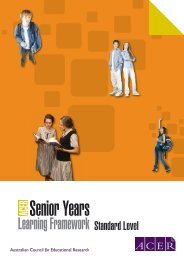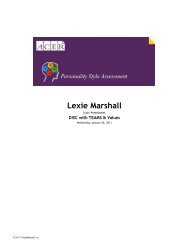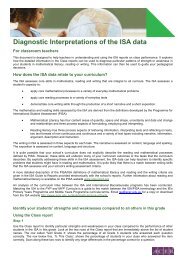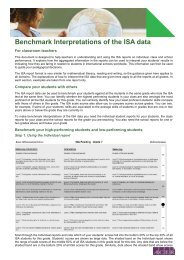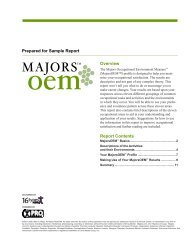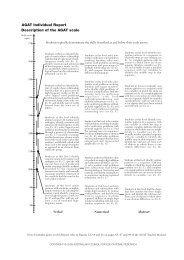National School Improvement Tool - ACER
National School Improvement Tool - ACER
National School Improvement Tool - ACER
Create successful ePaper yourself
Turn your PDF publications into a flip-book with our unique Google optimized e-Paper software.
Outstanding<br />
The school has a clearly documented whole-school plan for curriculum delivery. This plan is aligned with the Australian<br />
or other approved curriculum and, where appropriate, system curriculum documents. The plan makes explicit what<br />
(and when) teachers should teach and students should learn. The curriculum delivery plan is being implemented<br />
throughout the school and is shared with parents and the wider community.<br />
A strong alignment has been achieved between the overall curriculum delivery plan, term and unit plans, classroom<br />
teaching and the regular assessment of student progress in relation to curriculum expectations.<br />
Considerable attention has been given to ensuring ‘vertical’ alignment of the curriculum so that there is continuity and<br />
progression of learning across the years of school, with teaching in each year building on to and extending learning in<br />
previous years. General capabilities and cross-curriculum priorities are understood, valued and used as active learning<br />
streams for all students.<br />
A high priority in curriculum planning is given to the progressive development of students’ deep understandings of<br />
concepts, principles and big ideas within learning areas, as well as to the ongoing development of cross-curricular skills<br />
and attributes, including teamwork, critical thinking, problem solving, and the evaluation of information and evidence.<br />
The school places a priority on making the curriculum locally relevant and accessible to all students and values and builds on<br />
to students’ existing knowledge and varying backgrounds.<br />
High<br />
The school’s curriculum delivery plan identifies curriculum, teaching and learning priorities and requirements. The<br />
curriculum delivery plan reflects a shared vision (by the school’s governing body, principal, school leadership team,<br />
and teachers) for the school, and provides a context for delivering the curriculum as detailed in the Australian or other<br />
approved curriculum and, where relevant, system curriculum documents.<br />
The school curriculum plan and curriculum delivery (including the time allocated to particular learning) balance requirements<br />
to address all learning areas, to give priority to English, mathematics and science, and to embed the fundamental skills of literacy,<br />
numeracy and higher order thinking in all school subjects.<br />
The school leadership team ensures that the enacted curriculum remains a focus for discussion among, and<br />
collaboration between, teachers and that the curriculum plan is the reference against which flexible delivery is designed,<br />
assessment tasks are developed and student learning is reported. Curriculum delivery is designed to meet the needs of<br />
the range of students within each year level as well as those with disabilities and other particular needs.<br />
Medium<br />
The school has a documented plan for curriculum delivery that includes year level and term plans, but the progression of<br />
learning from year to year is not always obvious and the relationship between the pieces of the plan (the year, term and unit<br />
plans) would benefit from further clarification.<br />
<strong>School</strong> leaders talk about embedding fundamental cross-curricular skills such as literacy, numeracy and higher order<br />
thinking within all subjects, but there is little evidence that school-wide strategies are in place to drive a consistent<br />
approach. Literacy tends to be seen as the responsibility of English teachers and numeracy, the responsibility of<br />
mathematics teachers.<br />
Discussions about curriculum delivery tend to be sporadic and reactive with a year level focus rather than being driven<br />
by a leadership team with a whole-school approach.<br />
Low<br />
<strong>School</strong> leaders and teachers have limited familiarity with national or system-wide curriculum documents.<br />
The school may have a documented plan for curriculum delivery but there is little evidence that the whole-school plan<br />
drives the lesson plans of individual teachers.<br />
The enacted school curriculum is not seen as a central concern of all teachers (eg, it is not a regular topic of conversation,<br />
a focus for assessment design or a framework against which student learning is reported).<br />
13


